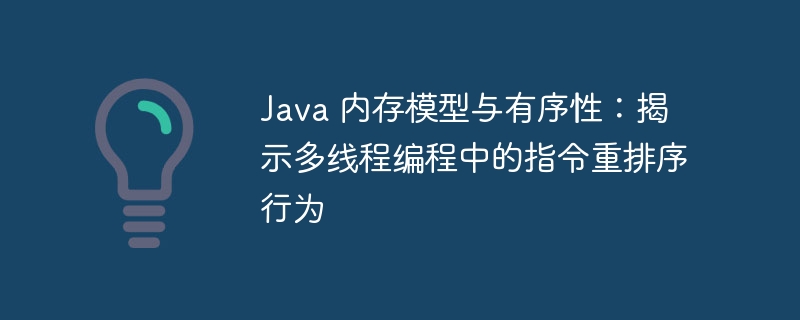

The article brought by php editor Banana will delve into the Java memory model and orderliness, and reveal the instruction reordering behavior in multi-threaded programming. In multi-threaded programming, instruction reordering may lead to unexpected results in the program. Understanding the Java memory model and ordering is crucial to avoid these problems. This article will explain in detail the principles and effects of instruction reordering to help readers better understand the hidden dangers and solutions in multi-threaded programming.
JMM defines the execution order of instructions in the program. Orderliness means that the order of execution of instructions in a program is consistent with the order of the source code of the program. JMM guarantees ordering of the following types:
In order to improve performance, the processor may reorder the order of instruction execution. This reordering does not change the final results of the program, but may cause the multithreaded program to behave differently than expected.
Instruction reordering may cause the following problems:
To avoid instruction reordering issues, you can use the following methods:
The following code demonstrates the problems that may result from instruction reordering:
public class ReorderingDemo {
private static int x = 0;
private static int y = 0;
public static void main(String[] args) throws InterruptedException {
Thread thread1 = new Thread(() -> {
x = 1;
y = 1;
});
Thread thread2 = new Thread(() -> {
if (y == 1) {
System.out.println("x is " + x);
}
});
thread1.start();
thread2.start();
thread1.join();
thread2.join();
}
}In this code, thread 1 first sets the values of x and y to 1, then thread 2 checks whether the value of y is 1, and if so, prints the value of x. If the processor reorders the instructions in thread 1, thread 2 may see that y has a value of 1 before x is set to 1, thus printing 0.
The Java memory model defines visibility and atomicity between variables in multi-threaded programming. Orderliness means that the order of execution of instructions in a program is consistent with the order of the source code of the program. Instruction reordering can cause multi-threaded programs to behave differently than expected. To avoid instruction reordering issues, you can use the volatile keyword, synchronized keyword, and atomic operations.
The above is the detailed content of Java Memory Model and Ordering: Uncovering Instruction Reordering Behavior in Multithreaded Programming. For more information, please follow other related articles on the PHP Chinese website!
 How to get the input number in java
How to get the input number in java
 How to open nrg file
How to open nrg file
 Bitcoin historical price chart
Bitcoin historical price chart
 How to deduplicate database in mysql
How to deduplicate database in mysql
 There are several output and input functions in C language
There are several output and input functions in C language
 Google earth cannot connect to the server solution
Google earth cannot connect to the server solution
 How to repair sql database
How to repair sql database
 What are the seven principles of PHP code specifications?
What are the seven principles of PHP code specifications?
 How to execute a shell script
How to execute a shell script




